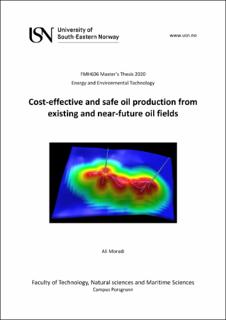| dc.description.abstract | Despite the rapid progress in the area of renewable energy, fossil fuels will remain the world’s most important energy source for the foreseeable future. Therefore, in order to meet future energy demands, increasing the efficiency of oil production and reducing carbon footprint from the oil and gas sector must be in the spotlight. One of the main principles of improving oil recovery is maximizing the reservoir contact, and long horizontal wells can be used for achieving this purpose especially in reservoirs with a thin oil column. However, there are some challenges related to horizontal wells like water coning towards the heel due to the heeltoe effect as well as early water breakthrough owing to heterogeneity along the well. In order to tackle these issues, well completion with passive inflow control devices (ICDs) and autonomous inflow control devices (AICDs) are widely used today. ICDs are able to balance the drawdown pressure along the horizontal well and as a result, postpone the early water breakthrough. By applying RCP valves, which are a special type of AICDs, water can be partially choked back in an autonomous way and the negative impacts of early water breakthrough will be attenuated. The Johan Sverdrup field is a giant oil field located in the North Sea and it started production in October 2019. With the aim of obtaining maximum oil recovery and minimum environmental footprint, cutting-edge technologies have been applied in this field and further studies are needed to improve these technologies. The main objectives of this thesis are nearwell simulation and study of oil production from a horizontal well with ICD and RCP completion. The simulations have been conducted based on the characteristics of the well number 16/2-D-12 in the Johan Sverdrup field by considering both homogeneous and heterogeneous reservoirs. OLGA in combination with ROCX has been used as a simulation tool. In this study, by using a new method based on developing a mathematical model and a control function for the RCP valves, the autonomous behavior of these valves has been implemented in OLGA.
The results showed that the well 16/2-D-12 with ICD and RCP completion can effectively handle the heel-toe effect and heterogeneity along the well, and consequently delay early water breakthrough and improve the oil recovery from this reservoir. Based on the simulation results, by using these inflow control devices for the well 16/2-D-12, the time of water breakthrough can be delayed by 253 days in the homogeneous reservoir and 255 days in the heterogeneous reservoir compared to the open-hole well. Moreover, it was observed that for the homogeneous and heterogeneous reservoirs, by completion of the well 16/2-D-12 with RCP valves, the accumulated water production can be reduced by 12.1% and 11.9% respectively during the first 750 days of production. Besides, using RCPs can reduce the flow rate of water production by 13.3% in the homogeneous and 13.4% in the heterogeneous reservoir after 750 days. For both homogeneous and heterogeneous reservoirs, by using RCP valves the outlet water cut can be reduced by 2.9% resulting in more cost-effective oil production. Furthermore, by evaluating the simulation results it can be concluded that using RCP valves has a negligible impact on both the accumulated oil production and the flow rate of oil production compared to using ICDs. Therefore, by completion of the well 16/2-D-12 with RCP valves more cost-effective oil production can be achieved. | en_US |
